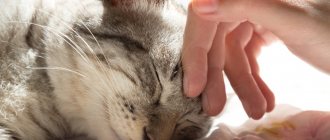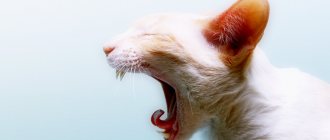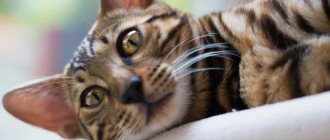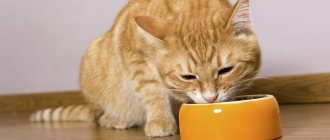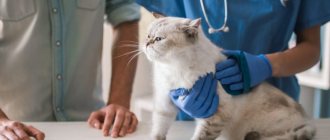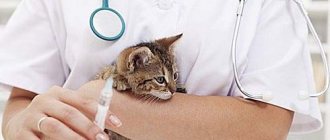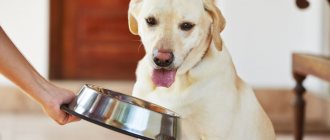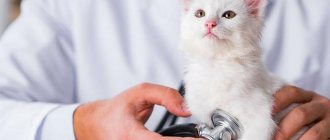Panleukopenia in cats symptoms
Symptoms appear 2-12 days after infection.
- Vomit
- Diarrhea
- Weakness
- Temperature rises to 40-41 degrees
- As the disease progresses, blood appears in the vomit and stool
- Lack of appetite
- The cat sits hunched over a bowl of water, but does not drink
- The animal tries to hide in a dark corner
- The fur loses its shine, becomes unkempt, and sticks out in different directions.
- Kittens often have damage to the nervous system: the animal becomes restless and very timid
- The animal may experience paralysis of the limbs; in this case, without assistance, death may occur within 24 hours
- Damage to the respiratory system is possible, inflammatory processes occur in the lungs
- The mucous membranes become covered with ulcers and pus.
- The animal is severely dehydrated
- Due to oxygen starvation, intoxication and dehydration, the mucous membranes of the mouth become pale and bluish
Diagnosis of the disease
A complete blood count of the cat shows a decrease in the number of leukocytes. PCR and ELISA studies can be carried out in private veterinary clinics. The latter is not a 100% indicator, since antibodies to the disease are constantly present in the bloodstream of some individuals. Confirmation of the disease is carried out by a doctor based on clinical and epidemiological data.
Note! Additionally, a test can be carried out on absolutely healthy kittens from prosperous areas of residence. If the fight ends in death, then the final diagnosis is based on information obtained after autopsy and examination of the biomaterial.
Prognosis: Panleukopenia in cats
Despite the severity of the disease, the animal has a chance to recover. With proper treatment, maintaining the animal's condition, good care and love, the cat will definitely recover. The general condition of the animal is also important, how strong the body is, what chronic diseases there are. A young domestic cat has a higher chance of recovery than an older cat.
In kittens up to 2 months of age, the mortality rate is almost 100%; in kittens older, but which do not receive treatment, the mortality rate is also 100%. With good care and proper treatment, the animal will recover!
Kittens and older animals need special care, of course it is more difficult with them. In young, active animals, the disease is easier and with proper treatment, recovery will definitely come!
With proper and timely veterinary care, the animal recovers in 5-10 days.
Monitor the water level
Make sure that the water level in the bowl never gets too low and do not fill it to the brim. Cats are creatures of habit and they really don't like change. Don't pour a full bowl one day and only half the next. Some cats start pawing at the water because they can't see the surface of the water and aren't sure where it might be today. Cats love consistency, so try to always pour water at the same level.
Cats are very mysterious creatures; many attribute magical properties to them, which raises many questions. Some of their habits raise no less questions, for example, burying a bowl of food.
When a person began to actively move from houses on the ground to comfortable apartments, of course, he began to miss communication with nature and animals. To fill this shortage, our favorite pet, a cat, comes to the rescue. A huge number of people have cats, because they are quite unpretentious and do not require walking like a dog.
Despite all the unpretentiousness of cats, sometimes some habit of a pet can even frighten. For example, a common question among owners is: “why does a cat bury its food bowl?” When this happens, owners often get scared and think that their animal is unhealthy, but in fact the reason is much simpler. To understand this issue, you need to remember about cat instincts and habits.
Panleukopenia in cats treatment at home
Treatment should be prescribed by a doctor after laboratory tests.
- First of all, it is necessary to combat dehydration; if diarrhea and vomiting are very severe, then the animal can quickly die. Making a Ringer Locke solution. 20 ml twice a day. Perhaps more, up to 100 ml per day, intermittently, perhaps administered at a time. We do it at the withers (if there is no possibility of a vein), this is for an adult animal, a smaller kitten, it is better to start with small doses and look at the condition. In very young kittens, quite often the solution cannot be absorbed and swelling occurs.
- Antibiotics, with panleukopenia, the immune system does not work and various diseases immediately begin to become attached. Antibiotic, for example, ceftriaxone 1.0 g. We dilute the antibiotic with 5 ml of novocaine 0.5%, do it once a day, in the hind paw. For a 4.5 kg cat we will need 1.3 ml of the finished product. You can read in detail about the intricacies of diluting the drug and dosages in this article: Ceftriaxone for cats and dogs An antibiotic is always necessary for this disease!
- Antiemetic - metoclopramide 0.1 ml per 1 kg of weight
- Immunomodulators, for example, feliferon. Dosage for an adult animal: for the first three days, apply 1 ml per hind paw, 1 time per day. Then 0.5 ml into the hind paw, also 1 time per day - duration 4 days.
- Vitamin injections. Vitamin C dosage 0.5 ml, 5% glucose 10 ml in the same syringe. We do it at the withers for 5 days. B vitamins are good, but it is worth remembering that they cannot be mixed and injected on the same day. One day I inject B1, another day B6. 0.2 ml, 2 times a day. If the kitten is up to 1 kg, 0.1 ml. Subcutaneously.
- Gamavit - according to instructions. Gamavit should not be given to older cats!
There are 5 rules to carefully learn how to bathe your cat.
Getting an unprepared cat to take a bath is a real challenge and serious stress. Such experiments can end not only with scratches on your hands, but also with a cat that will no longer trust its owner. While scratches may take a long time to heal anyway, dealing with an animal's psychological wounds takes a long time.
To avoid trouble, it is necessary to properly accustom the kitten to water procedures; it is better to follow these tactics:
- Prepare a towel in advance, open the shampoo and close the bathroom door;
- Adjust the water pressure and temperature by testing it with your hand. It should not be felt sharply on the skin;
- It is better to place the cat in the bath while holding him in your hand, which will give him less room to maneuver and scratch;
- Lather the shampoo and distribute the foam evenly throughout the body, starting from the back of the body.
- The movements should be up and down, avoiding the area around the eyes, ears and nose;
- Once completed, wrap the cat in a towel and squeeze the animal to calm it down.
- After drying with a towel, the cat can be released and sent home.
It is important to understand that time and patience are the best allies in the difficult task of getting rid of the fear of water and getting used to water procedures. But it’s worth it, because bathing will become, if not the cat’s favorite pastime, then at least tolerable. After all, cats are amazing creatures that make our lives richer, brighter and more interesting, and we ourselves are better and kinder.
See also: How often can you wash your cat?
Caring for a cat when sick
In the first days, if the cat refuses to eat, you should not force feed it. Nutrition and water are important after vomiting has been controlled and treatment has begun to take effect. The cat is weakened, now good, easily digestible food is important for recovery, for example, chicken broth or baby food (turkey, chicken, beef), specialized food is possible, for sick, weakened animals, always in the form of pate. Food should be soft and warm. If the cat does not eat on its own, it must be force-fed. We administer nutrition through a syringe without a needle. Be sure to give the animal water.
You can give your animal decoctions of herbs that have anti-inflammatory and expectorant effects.
The cat needs to be provided with a quiet, peaceful place to sleep, good nutrition, complete, timely, correct treatment and, of course, surround the pet with love and care.
The room where the cat is located should be warm, there should be no drafts, doors and vents should be closed. Under no circumstances should the animal be allowed to go outside.
The cat must be in a clean room. Wash bowls with chlorhexidine after every meal.
When is it normal to refuse water?
If the animal is on a natural diet, refusing water should not cause concern. When a cat eats meat, vegetables and other natural foods, its body receives a sufficient amount of fluid from food, so it does not need water.
In addition, animals that “walk on their own” may not drink water at home, but get it from the street. Often domestic cats are fed from neighbors, where they can get water. Cats that eat dry food at home can periodically go outside to hunt. A caught and eaten pigeon, sparrow or mouse completely covers the body's need for fluid.
Conclusion: if the owner does not see the cat drinking water, this does not always mean that the cat is not drinking. In the case of natural food in a pet’s diet, a complete refusal of water is the norm.
Prevention of Panleukopenia
If there are other cats in the family, then quarantine is necessary, communication should not be allowed, the sick cat should have separate bowls and a separate place to sleep. We exclude all contact with healthy cats. A cat that has recovered from the disease will continue to be a carrier of the virus for a long time and pose a danger to other relatives.
To prevent the disease, vaccination is necessary; kittens are vaccinated from two months of age, the schedule is determined by the doctor. Adult cats are revaccinated every year.
Another important point is to maintain hygiene, limit animals’ access to outdoor shoes, and disinfect premises.
Health to your dear pets!
Reflexes, instincts, habits of cats
The cat is originally a predator; it has retained a wide variety of instincts and unconditioned reflexes. Instinct is the ability to act one way and not another, guided by subconscious beliefs.
All instincts can be divided into three main groups:
- The first group includes instincts that ensure the functioning of the body: food instinct, sleep instinct, etc. These instincts are simply necessary for any animal; life is impossible without them.
- The second group includes instincts that help individuals communicate and interact: parental instinct, sexual instinct, etc.
- The third group includes: the instinct of play, exploration and imitation.
When doing certain things, a cat is guided by its instincts, therefore, if a cat grabs a bowl with its food, this can be explained by the presence of certain instincts and reflexes in all cats.
Should I adopt a new kitten if there was panleukopenia?
The likelihood that a new animal will become infected is very high. To prevent this from happening, you need to thoroughly disinfect the house and take a kitten from healthy, vaccinated parents, or better yet, an already grown-up kitten that has been vaccinated!
The virus can be transmitted from an animal that has been ill for a long time for quite a long time; the virus can be stored in the house for quite a long time, so as not to take risks, it is better to take an animal with good immunity and vaccinations.
The likelihood of disease also increases during cool and damp seasons. If there was a disease in the house and you decided to take a kitten from the street, it’s autumn and dirt outside, then the probability that the animal will get sick is almost 100%!
How to tell if your cat is not drinking enough water
An acute lack of fluid in the body at the cellular level leads to the fact that the cellular structures shrink, the blood and lymph circulating throughout the body become much thicker. Oxygen does not penetrate the cells in the required quantity, oxygen starvation occurs. Against the background of dehydration and serious disorders, pathological changes occur in the intestinal tract, ureter, and respiratory tract. The pet becomes lethargic, the coat becomes dull, and the animal’s state is apathetic.
It is necessary to understand that young animals in good health can be without drinking water for a long time - for 3-4 days. The older the animal is or has a history of a number of chronic diseases, the higher the risk of pathological changes when dehydration occurs. The body's reserves are depleted, which provokes severe problems, which ultimately leads to death.
Unlike dogs, cats are not particularly fond of drinking water, especially in large quantities. However, their need for clean drinking water is significant. Cats need much less fluid per day than dogs or other animals, but without water the body cannot function normally.
As a result of the fact that water is an important component of both cellular structures and intercellular space, the biological properties and structures of elements are determined, influencing the process of thermoregulation of the body and the transfer of useful components.
Regular loss of fluid occurs in the body along with salivary fluid, urine and feces. In the absence of replenishment, serious complications arise that provoke problems in the functioning of the entire body.
If a cat refuses to drink on its own, the risk of dehydration increases. Against the background of dehydration of the whole body, internal organs begin to suffer, and first of all, the central brain. All metabolic processes in cells are disrupted.
Scientists have proven that with a percentage loss of body fluid of up to 10%, there is a high risk of developing irreversible processes in the tissue structures of the body. If the percentage of fluid loss exceeds 15-20%, the animal may die. Dangerous conditions that lead to a sharp development of dehydration are stool disorders (profuse diarrhea), persistent vomiting, extensive hemorrhages (especially internal bleeding) against the background of injuries to internal organs, edematous conditions. In addition to fluid, the body loses a large amount of microelements, vitamins and other nutrients.
Such conditions and changes in the body are difficult to normalize. As soon as the owner notices a problem in the pet’s health, it is recommended to immediately contact a veterinary clinic for help. Only in a hospital hospital setting is it possible to carry out infusions of saline solutions, glucose or other substances that maintain the body’s water balance at the required level, avoiding the development of complications.
Consequences and pathological changes in the cat’s body
Common complications of panleukopenia in cats include:
- the addition of secondary infections with the development of pneumonia, enteritis;
- hepatitis, nephritis, seizures, neurological abnormalities;
- disturbances in the process of blood production;
- miscarriages, infertility in cats;
- developmental and growth disorders in young animals;
- chronic constipation.
What kind of pathology is this, leukopenia in cats? It is a consequence of the activity of bacteria in the body. A decrease in the number of leukocytes leads to a weakening of protective barriers, allowing any infections to easily penetrate.
For your information! Leukopenia in cats is often accompanied by neutropenia - a critical decrease in the number of neutrophils.
The pathogen is not transmitted to humans and other pets: dogs, rodents. The disease is not dangerous and does not threaten their health.
